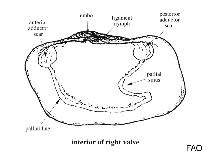Panopea abbreviata (Valenciennes, 1839)
Southern geoduck
Upload your photos
Google image | No image available for this species;
drawing shows typical species in Hiatellidae.
Google image | No image available for this species;
drawing shows typical species in Hiatellidae.
Classification / Names Common names | Synonyms | CoL | ITIS | WoRMS
Bivalvia | Adapedonta | Hiatellidae
Environment: milieu / climate zone / depth range / distribution range Ecology
Benthic; depth range ? - 75 m (Ref. 80608). Subtropical; 23°S - 48°S (Ref. 80608)
Distribution Countries | FAO areas | Ecosystems | Occurrences | Introductions
Endemic to Southwest Atlantic.
Length at first maturity / Size / Weight / Age
Maturity: Lm ? range ? - ? cm Max length : 11.0 cm SHL male/unsexed; (Ref. 80608); max. reported age: 40 years (Ref. 80608)
Life cycle and mating behavior Maturity | Reproduction | Spawning | Eggs | Fecundity | Larvae
Members of the class Bivalvia are mostly gonochoric, some are protandric hermaphrodites. Life cycle: Embryos develop into free-swimming trocophore larvae, succeeded by the bivalve veliger, resembling a miniature clam.
Main reference
References | Coordinator | Collaborators
Morsan, E. and N.F. Ciocco. 2004. (Ref. 80608)
IUCN Red List Status (Ref. 130435: Version 2024-1)
CITES status (Ref. 108899)
Not Evaluated
CMS (Ref. 116361)
Not Evaluated
Threat to humans
Harmless
Human uses
Fisheries: commercial
| FishSource |
Tools
More information
Trophic Ecology
Food items
Diet
Food consumption
Ration
Predators
Diet
Food consumption
Ration
Predators
Ecology
Life cycle
Distribution
Human Related
Aquaculture profile
Stamps, Coins Misc.
Stamps, Coins Misc.
Outreach
Taxonomy
References
Internet sources
BHL | BOLD Systems | CISTI | DiscoverLife | FAO(Publication : search) | Fishipedia | GenBank (genome, nucleotide) | GloBI | Gomexsi | Google Books | Google Scholar | Google | PubMed | Tree of Life | Wikipedia (Go, Search) | Zoological Record



